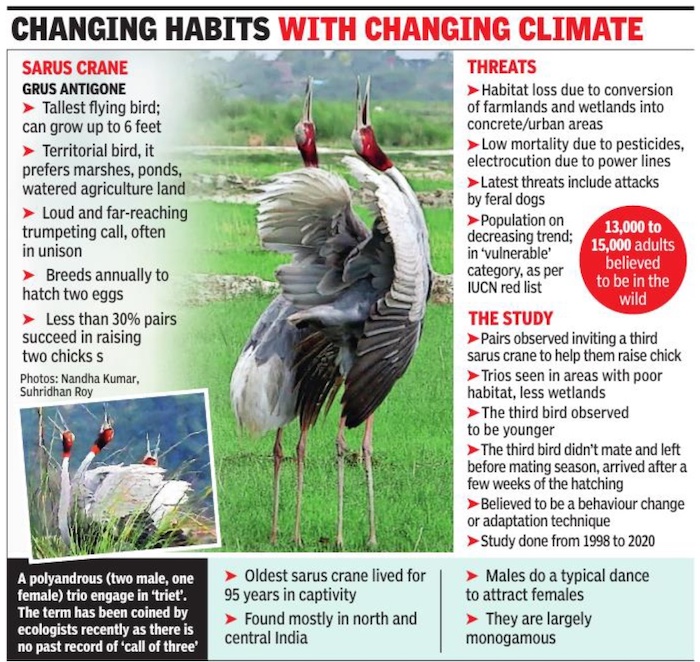Sarus cranes: India
This is a collection of articles archived for the excellence of their content. |
Social habits
Trios
Kushagra Dixit, April 11, 2022: The Times of India

From: Kushagra Dixit, April 11, 2022: The Times of India
New Delhi: The sarus crane,the world’s tallest flyingbird, is changing its social habits due to climate change. The water bird is monogamous, meaning it pairs up for life.
Three Indian ecologistshave discovered the birds forming a trio by allowing a thirdsarus crane to join themand help them raise chicks intougher conditions. The study titled ‘SarusCrane (Antigone) Trios andtheir Triets: Discovery of aNovel Social Unit in Cranes’,published in Ecological Society of America Journal, observed this phenomenon inlandscapes of poor quality,that is with fewer wetlandsand fewer sarus pairs. K. S. Gopi Sundar, Suhridam Roy and Swati Kittur conducted the study between 1998and 2020 in Lumbini in Nepal,Uttar Pradesh, Rajasthan, Gujarat and Delhi-NCR. They pointed out that studying habitat conditions and their relation to trio formations was important because “behaviourssuch as monogamy in long-lived birds is being altered by climate change”. The new finding is interesting because the sarus crane doesn’t change its behaviour easily.
“Sarus are the old clade (a branch with common ancestor) and have existed for over 170 million years compared with songbirds which evolved 4-5 million years. This makes our observation very peculiar,” said Sundar, who is a scientist at Nature Conservation Foundation and co-chair of IUCN Stork, Ibis and Spoonbill Specialist Group. “The forming of trios had been observed in some old clade birds such as albatross and swan, which also are monogamous but had recently became polygamous because of climate change. Something similar is now being seen in sarus cranes. ” While research on the phenomenon is continuing, the ecologists have observed that the third bird — male or female — is younger and doesn’t breed. “The third bird doesn’t mate. It vanishes from the territory during the mating or breeding season and returns after the chicks are at least a month old,” said Sundar. “We are investigating the benefits for the pair in forming thetrio, but it seems the pair getobvious help in raising thechicks in the tough habitatand the third crane getexposure and experience onhow to raise chicks. ”Unlike in swans, wheremost trios observed were polygynous (more than one female), the sarus crane also showed polyandrous (more thanone male) tendency. The firstpolygynous trio was seen inEtawah district in UP in 1999. “Each year, one of the females disappeared as nesting commenced and the remaining pair nested, incubated eggs and provisioned young chicks.
In unsuccessful years, the second female re-joined the pair immediately after the nest oreggs were lost. In successfulyears, the second female re-joined the pair only after chicksfledged (over 45 days) and participated in provisioningchicks. The trio raised at leastone chick to fledging in five of11 years,” the study says. The study however foundthat only a few pairs formedthe trios. They also observedthat the loud trumpetingcall — to defend territoryand form pairs — in unisonand, therefore, called a ‘duet’has changed to a ‘triet’, anew coinage. “The trio sounded triets when other cranescame close to their territory,”the study observed. In the study, among thesightings of 11,591 sarus cranegroups, 193 (1. 6 %) were trios. “Trios in other bird speciesimproved brood success. The breeding success of the sarustrio observed over multipleyears was high despite being in a low-quality territory,which suggests that polygynous trios potentially improvefitness,” the study says. “Moretrios were seen in low qualityareas and during summers,suggesting that poor habitatconditions may force pairs tooff-set potential risks of lowbreeding success by gaining ahelper to raise chicks. ”The research establishedthat the sarus are “great parents”. “This old-clade birdis not just faithful to its matebut is also a great parent,”said Sundar. “It is alteringits monogamous and othercore behaviours to raise itschicks well. This is anincredible adaptation. ”
Keshopur
The Times of India, Mar 4, 2016
Sarus cranes find new home in Keshopur wetland
Finding ideal conditions for habitation, two pairs of endangered sarus cranes (grus antigone) have made their adobe in Keshopur wetland of Gurdaspur. Instead of flying back to their native place in India, the birds have been living in the nation's first community reserve during 2014 and 2015.
Pathankot district forest officer (wildlife) Rajesh Mahajan said it was possible only after they improved bird habitat measures in the wetland. He informed that they removed weed from over 125 acres to increase the available water surface area, planted 3,000 tall indigenous trees for roosting and nesting of birds, prepared nearly 8km nature trail for better connectivity and desilted the area for increasing water level besides preparing uplands for resting of birds. He said every year eight to 10 pairs of sarus cranes come to Keshopur, but for the past two years, two pairs have made it their abode which was an encouraging sign. Mahajan said in 2011, the bird count in the wetland was 4,511. "After we took up the habitat improvement project, the bird count gradually started rising. It was 8,500; 13,600; 18,500; 20,200; and 25,300 in 2012, 2013, 2014, 2015 and 2016, respectively," said the DFO (wildlife).
Earlier, Keshopur wetland was spread over 2,800 acres land in three villages -- Miani, Keshopur and Magarmudia Dalla. "The panchayats of these villages gave the land of the wetland on contract to fish farms and for agriculture. Use of nets and chemicals to catch fish and birds would also kill the migratory birds and their number started dropping," said Mahajan. He said with encroachments and cultivation of land, the area shrunk to just 850 acres and in 2006 the Keshopur 'chhamb' (water body) was declared a community reserve following which certain restrictions were imposed and it started flourishing as wetlands attracting migratory birds. He informed this year they recorded arrival of 800 common cranes in the Keshopur wetland.